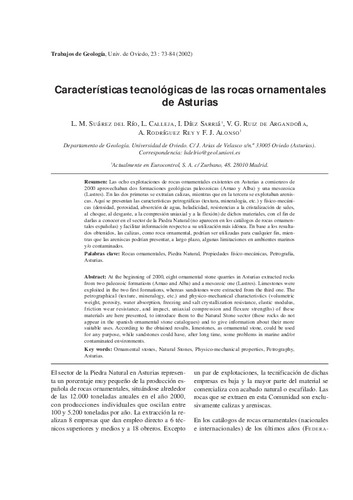Características tecnológicas de las rocas ornamentales de Asturias
Subject:
Rocas Ornamentales
Piedra Natural
Propiedades Físico-Mecánicas
Petrografía
Asturias
Ornamental Stones
Natural Stones
Physico-Mechanical Properties
Petrography
Publication date:
Editorial:
Universidad de Oviedo, departamento de geología
Citación:
Descripción física:
Abstract:
Las ocho explotaciones de rocas omamentales existentes en Asturias a comienzos de 2000 aprovechaban dos formaciones geológicas paleozoicas (Amao y Alba) y una mesozoica (Lastres). En las dos primeras se extraian calizas, mientras que en la tercera se explotaban areniscas.Aqui se presentan las caracteristicas petrograficas (textura, mineralogia, etc.) y fisico-mecánicas (densidad, porosidad, absorción de agua, heladicidad, resistencias a la cnstalizaci6n de sales,al choque, al desgaste, a la compresion uniaxial y a la flexión) de dichos niateriales, con el fin de darlas a conocer en el sector de la Piedra Natural (no aparecen en los catálogos de rocas ornamentales españolas) y facilitar información respecto a su utilización más idónea. En base a los resultados obtenidos, las calizas, como roca ornamental, podrian ser utilizadas para cualquier fin, mientras que las areniscas podrian presentar, a largo plazo, algunas limitaciones en ambientes marinos y/o contaminados.
Las ocho explotaciones de rocas omamentales existentes en Asturias a comienzos de 2000 aprovechaban dos formaciones geológicas paleozoicas (Amao y Alba) y una mesozoica (Lastres). En las dos primeras se extraian calizas, mientras que en la tercera se explotaban areniscas.Aqui se presentan las caracteristicas petrograficas (textura, mineralogia, etc.) y fisico-mecánicas (densidad, porosidad, absorción de agua, heladicidad, resistencias a la cnstalizaci6n de sales,al choque, al desgaste, a la compresion uniaxial y a la flexión) de dichos niateriales, con el fin de darlas a conocer en el sector de la Piedra Natural (no aparecen en los catálogos de rocas ornamentales españolas) y facilitar información respecto a su utilización más idónea. En base a los resultados obtenidos, las calizas, como roca ornamental, podrian ser utilizadas para cualquier fin, mientras que las areniscas podrian presentar, a largo plazo, algunas limitaciones en ambientes marinos y/o contaminados.
At the beginning of 2000, eight ornamental stone quarries in Asturias extracted rocks from two paleozoic formations (Amao and Alba) and a mesozoic one (Lastres). Limestones were exploited iii ihe two tirst formations, whereiis sdndstoties wem extracted from the third one. The petrographical (texrure, mineralogy, etc.) and physico-mechanical characteristics (volumetric weight, porosity, water absorptioii, frcczing and sal1 crystallization resisrance, elastic modulus, friction wear resistance, and impact, uniaxial compression and flexure strengths) of these materials are hcre presentcd, to introduce thcm to the Natural Stone sector (these rocks do not appear in the spanish ornamental stone catalogues) and to give infomation about their more suitable uses. Accvrding to the obtained results, limestones, as ornamental stone, could be used for any purpose, while sandstones could have, after long time, some probleins in marine andior contaminated environments.
At the beginning of 2000, eight ornamental stone quarries in Asturias extracted rocks from two paleozoic formations (Amao and Alba) and a mesozoic one (Lastres). Limestones were exploited iii ihe two tirst formations, whereiis sdndstoties wem extracted from the third one. The petrographical (texrure, mineralogy, etc.) and physico-mechanical characteristics (volumetric weight, porosity, water absorptioii, frcczing and sal1 crystallization resisrance, elastic modulus, friction wear resistance, and impact, uniaxial compression and flexure strengths) of these materials are hcre presentcd, to introduce thcm to the Natural Stone sector (these rocks do not appear in the spanish ornamental stone catalogues) and to give infomation about their more suitable uses. Accvrding to the obtained results, limestones, as ornamental stone, could be used for any purpose, while sandstones could have, after long time, some probleins in marine andior contaminated environments.
Files in this item




